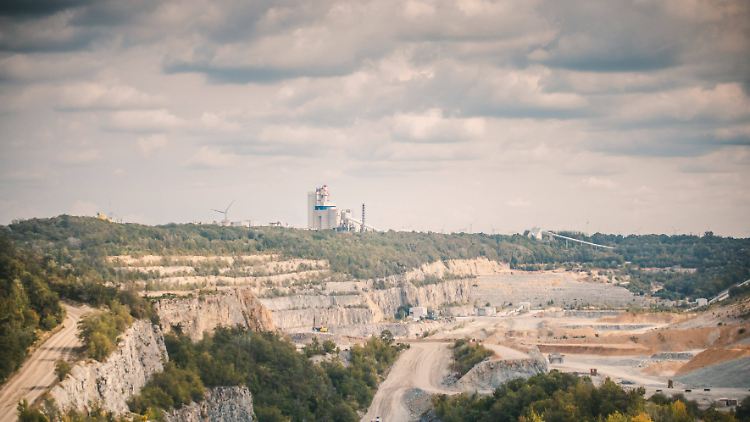Waste heat is the world’s largest untapped energy resource, say companies like Orcan Energy. But even if they want to, classic sources such as data centers often do not find direct buyers. Andreas Sichert is not surprised. Because waste heat is usually produced far away from residential areas, explains the boss of Orcan Energy in the “climate laboratory” of ntv. Another problem: The supply of waste heat in Germany is much larger than the annual heat demand. Sichert therefore advocates a different approach. Waste heat giants such as glassworks or cement works can produce their own electricity inexpensively on site from their waste heat and in this way reduce their energy requirements by up to 25 percent. “And because the electricity is generated exactly where you need it, you don’t need a new network,” says Sichert. “Since the CO2 emissions are also reduced, one operates profitable climate protection.”
ntv.de: In Frankfurt heating soon 1300 households with the waste heat a data center. The operators would like to emit even more heat, but cannot find any other buyers. How can that be when there is a dispute about the heat transition and the heating law at the same time and many people fear the expensive heat pump?
Andreas Sichert: That’s easy to explain. Waste heat is usually produced where there is no direct consumer either in terms of location or time. If we leave the data center and think of industrial companies such as steel works, cement works or glassworks, …
… operates the largest cement works in Germany in Rüdersdorf. It is currently being equipped by Orcan Energy to generate electricity from the waste heat in the future.
(Photo: imago images/Christian Kielmann)
… all of which have work processes that generate an incredible amount of heat?
Absolutely. Some material is created or formed. And the energy that is needed for this is not chemically bound in this material, but in most cases is lost unused in the form of waste heat. A glass melting furnace is heated with gas and runs 24 hours a day, seven days a week for 10 to 14 years. If you turned off the furnace and that molten glass hardened, you could throw the furnace away.
The oven stays on all the time?
And produces waste heat around the clock. But these works are rarely in a residential area. But even if you had buyers: The year has 8760 hours. In Germany, however, we only need 2,500 to 3,500 hours of heating energy. Even with direct customers, more than 5000 hours of heating energy from waste heat would be wasted every year.
Because it’s warm enough most of the time?
Yes. We don’t have to heat in the summer. So during this time I have no use for waste heat in a residential area. And in the case of cement plants, each one produces 7,000 to 7,500 hours of heating energy per year. But when does the plant stand still and maintenance work is carried out?
On Christmas day?
Every time an engine runs, it generates heat. The same applies to computers, but also refrigerators – and on a larger scale also to supermarkets, data centers, factories, sewage treatment plants, subway stations and commercial buildings. This waste heat can be reused on site as a heat solution. Excess heat can also be fed into a district heating system and passed on to neighboring households and companies. Local power generation is also possible with solutions such as those from Orcan Energy. The potential is huge: Danfoss – a Danish company for refrigeration and heating technology – is coming in a new Investigation to the conclusion that waste heat the largest untapped energy source in the world is. In the EU it is Excess heat is therefore 2,860 TWh per year and thus the entire energy requirement of the EU for heat and hot water in residential and service buildings. According to Orcan Energy, with efficient use, annually 750 million tons of CO2 are avoided.
Nearly. A bit in December, but especially in January and February when there is frost on the site and you can’t work. So whenever I could use waste heat from a cement plant for heating, this source is not running. And even if supply and demand match, it can happen that there are many kilometers between the supplier and the buyer. Because digging heat pipes under motorways would be very time-consuming. If we break away from the mainland and think of shipping, where engines produce electricity, energy and waste heat … a flexible district heating line from Hamburg to Singapore will be rather difficult. To cut a long story short: The direct use of waste heat is great, but in most cases it is not possible.
Nevertheless, you want to earn money with waste heat with your company. What solutions did you find for the above problems?
Waste heat can be found in many processes in the modern world, but in most cases it cannot be used directly for heating. That’s why we convert waste heat. Something you can always use: electricity. Let’s think again about the glass works or the cement works. They can produce their own electricity with waste heat on site – similar to PV and wind and totally grid-friendly without additional lines. I reduce my electricity purchase from the grid and thus even relieve transmission and distribution grids.
And save money.
Exactly. My CO2 emissions are also reduced. That works in the cement works, in the steel works, in the glass works. And even if I don’t need the electricity: We have equipped biogas plants that feed the electricity into the grid for someone else. Because everything that is produced is typically already connected to the power grid.
Could a data center use its waste heat for heating in winter, but generate electricity from it in summer?
That’s a great idea and could theoretically work. The only catch is that waste heat in typical data centers only reaches relatively low temperatures because they are cooled with air. At the ventilation, where the warm air is blown out, they are only around 40 degrees. In order to generate electricity at all, you need 65 to 70 degrees hot air.
So the waste heat should be hotter?
We offer small steam power plants, so to speak, like the ones we used to get to know at school. Conventionally, coal, oil, gas or even nuclear fuel is burned in it and water is evaporated. At high temperatures and under high pressure, the water vapor drives a turbine that is attached to the generator and produces electricity. In a cooling tower, the vapor becomes liquid again and the cycle begins again. Our devices do nothing else. However, we do not use water, but an organic, non-toxic working medium that starts to evaporate at 17 degrees. So we can use very low temperatures to create vapor. If we were to use a liquid waste heat medium, we could generate electricity economically from 80 degrees.
And you don’t reach these temperatures in data centers, but you do in industrial companies?
The industry has always thought that anything above 300 degrees can be used for a large steam turbine. In the meantime, we have simplified the large-scale power plant technology to such an extent that our solution can be bought as a product and used economically even at lower temperatures. Similar to a heat pump. You don’t have to bother with a plant engineer anymore. We install turnkey systems so that many users can make use of their waste heat, which is expensively produced in normal processes anyway.
So you go to a cement plant and install your machine?
Exactly. There are two typical waste heat sources in cement works. A heat exchanger can be installed in both, which extracts the heat from the hot exhaust gases and heats up the water. This hot water – which typically reaches temperatures of 150 degrees for us – then goes into our products. They generate electricity from it.
And can the cement works use the electricity itself?
You can find the climate laboratory on ntv and wherever there are podcasts: RTL+ music, Apple Podcasts, Amazon Music, Google Podcasts, SpotifyRSS feed
Yes. If both sources are used, the power requirements of a cement plant can be reduced by around a quarter – and lucratively so. Our solution can definitely keep up with PV and wind and has the advantage that it always produces automatically when the plant is running and there is a demand for electricity. And because the electricity is generated exactly where it is needed, there is no need for new grids. Since CO2 emissions are also reduced, profitable climate protection is being pursued.
And how much electricity could be saved across Germany if all cement works and co. used their waste heat?
A city like Mannheim could be supplied with the electricity that we could generate from the waste heat of all German cement works. That’s substantial. And the waste heat that is not used is energy that is simply wasted. It just gets blown out every hour. Or even worse: As in cement works, it is even cooled away with additional power consumption.
What would it take politically to advance this expansion quickly? Would a quota or an obligation that waste heat must be used help?
Something like this was introduced in the biogas sector, but as always there were two billion loopholes. I doubt such a thing makes sense. I’m not a fan of prohibitions, I would rather have benefits if you exploit your own potential. A simple and pragmatic approach, like the US Inflation Reduction Act. You explain what you are doing and that is encouraged and rewarded. Then new, modern things emerge and what is no longer worthwhile is automatically no longer done.
So we need financial incentives?
It doesn’t just have to be financial. Clear regulations between the federal government, the federal states and the EU would also be helpful. Look at the EU taxonomy: nuclear power is green. Electricity from fossil natural gas is green. Heat from waste heat is green. But not electricity from waste heat. There simply wasn’t a lobby for that back then.
Talked to Andreas Sichert Clara Pepper and Christian Herrmann. The conversation has been shortened and smoothed for better understanding.
What helps against climate change? “Klima-Labor” is the ntv podcast in which Clara Pfeffer and Christian Herrmann examine ideas and claims that sound great but rarely are. Climate neutral companies? lied Climate killer cow? Misleading. artificial meat? Horror 4.0. Reforestation in the south? Exacerbates problems. CO2 prices for consumers? Inevitable. LNG? Expensive.
The climate laboratory – half an hour every Thursday that provides information and cleans up. On ntv and everywhere there are podcasts: RTL+ music, Apple Podcasts, Amazon Music, Google Podcasts, SpotifyRSS feed

